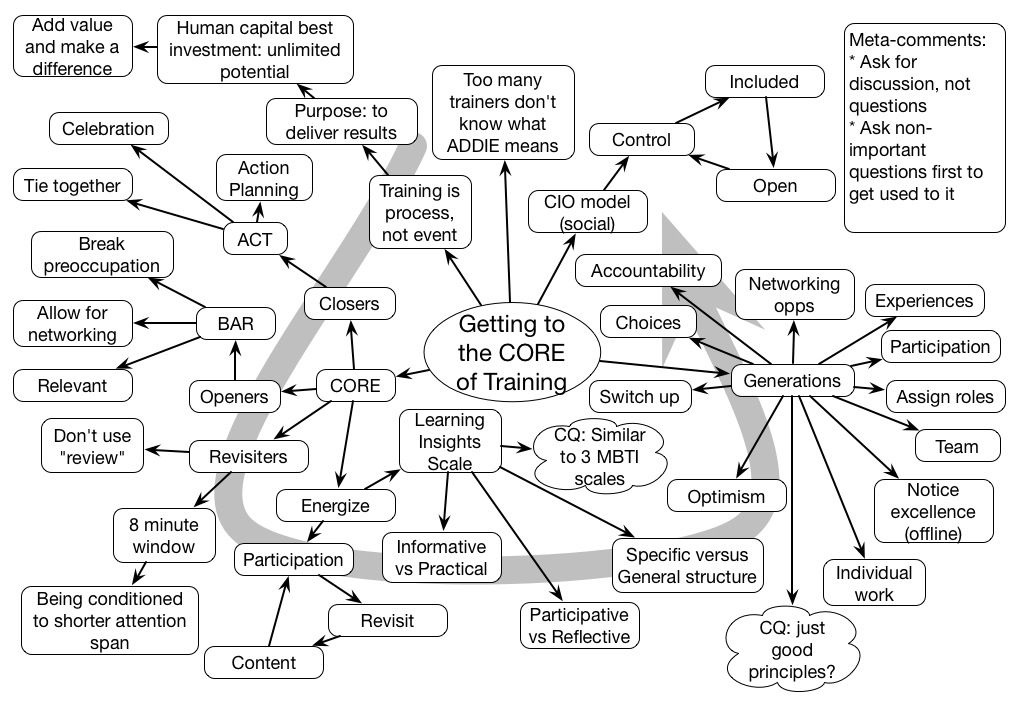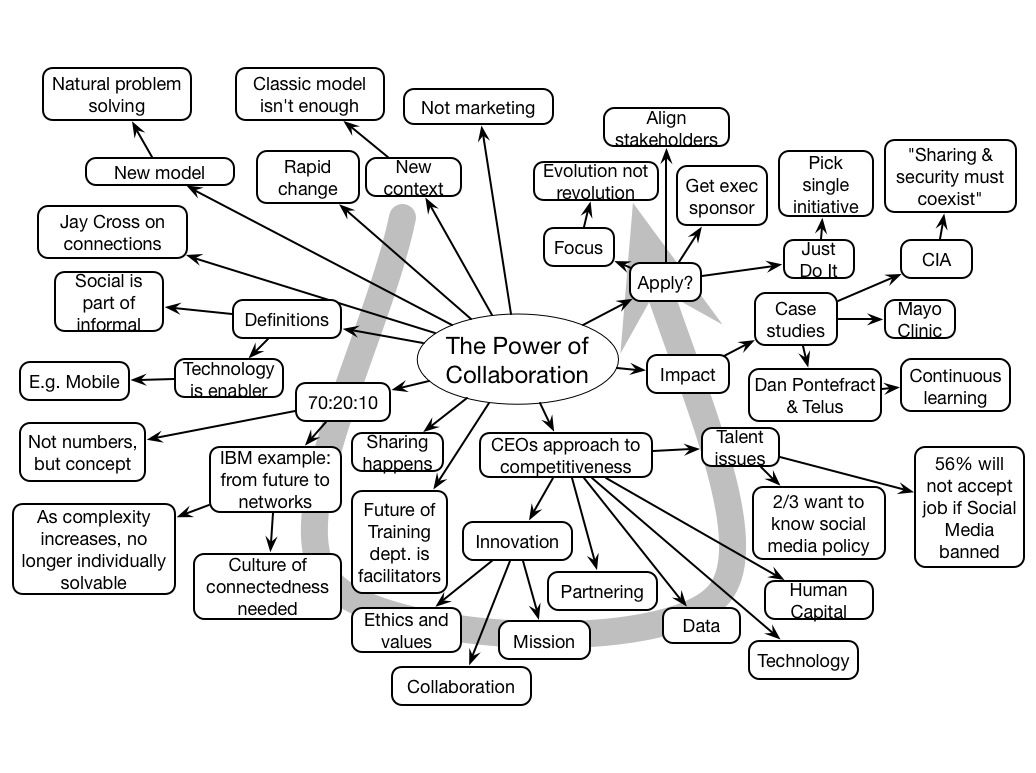Bob Pike launched the third and final day of ASTD’s Middle East and North Africa event with a keynote that took some well-established principles of good learning design and put his own unique and engaging spin on them. Along the way he discussed learning styles (in a different phrase) and generations. And he certainly practices what he preaches.
Dr. Palan #ASTDMENA Keynote Mindmap
At the ASTD Middle East North Africa event, Dr. Palan opened the second day by weaving a well-illustrated talk about how leadership is changing, moving from transactional to transformational.
Tony Bingham #ASTDMENA Keynote Mindmap
Today’s opening keynote for the ASTD Middle East North Africa event was ASTD’s leader, Tony Bingham. Tony did a clear and cogent argument for social media in organizations, without shootouts to Jay Cross, 70:20:10, Dan Pontefract, Marcia Connor, the Mayo Clinic, IBM, the CIA and more.
ITA Predictions 2013
The Principals of the Internet Time Alliance decided to take a collective look ahead to the new year, and share our predictions. You‘ll see overlap but also unique perspectives:
Charles Jennings
 An increasing number of organisations, independent of size, nature or location, will acknowledge that their traditional training and development models and processes are failing to live up to the expectations of their leaders and workforce in a dynamic and global marketplace. Some will take steps to use their financial and people resources and exploit new ways of working and learning. Others will be hamstrung with outdated skills, tools and technologies, and will be too slow to adapt. A confluence of technology and improved connectivity, increasing pressures for rapid solutions and better customer service, and demands for higher performance, will force the hands of many HRDs and CLOs to refocus from models of ‘extended formal training‘ to place technology-enabled, workplace-focused and leader-led development approaches at the core of their provision. We will move a step or two closer to real-time performance support at the point of need.
An increasing number of organisations, independent of size, nature or location, will acknowledge that their traditional training and development models and processes are failing to live up to the expectations of their leaders and workforce in a dynamic and global marketplace. Some will take steps to use their financial and people resources and exploit new ways of working and learning. Others will be hamstrung with outdated skills, tools and technologies, and will be too slow to adapt. A confluence of technology and improved connectivity, increasing pressures for rapid solutions and better customer service, and demands for higher performance, will force the hands of many HRDs and CLOs to refocus from models of ‘extended formal training‘ to place technology-enabled, workplace-focused and leader-led development approaches at the core of their provision. We will move a step or two closer to real-time performance support at the point of need.
Clark Quinn
 We‘ll see an increasing use of mobile, and some organizations will recognize the platform that such devices provide to move the full suite of learning support (specifically performance support and informal learning) out to employees, dissolving the arbitrary boundaries between training and the full spectrum of possibilities. Others will try to cram courses onto phones, and continue to miss the bigger picture, increasing their irrelevance. Further, we‘ll see more examples of the notion of a ‘performance ecosystem‘ of resources aligned around individual needs and responsibilities, instead of organized around the providing silos. We‘ll also see more interactive and engaging examples of experience design, and yet such innovative approaches will continue to be reserved for the foresightful, while most will continue in the hidebound status quo. Finally, we‘ll see small starts in thinking semantic use in technology coupled with sound ethnographic methods to start providing just such smart support, but the efforts will continue to be embryonic.
We‘ll see an increasing use of mobile, and some organizations will recognize the platform that such devices provide to move the full suite of learning support (specifically performance support and informal learning) out to employees, dissolving the arbitrary boundaries between training and the full spectrum of possibilities. Others will try to cram courses onto phones, and continue to miss the bigger picture, increasing their irrelevance. Further, we‘ll see more examples of the notion of a ‘performance ecosystem‘ of resources aligned around individual needs and responsibilities, instead of organized around the providing silos. We‘ll also see more interactive and engaging examples of experience design, and yet such innovative approaches will continue to be reserved for the foresightful, while most will continue in the hidebound status quo. Finally, we‘ll see small starts in thinking semantic use in technology coupled with sound ethnographic methods to start providing just such smart support, but the efforts will continue to be embryonic.
Harold Jarche
 People who know nothing about connectivism or collaborative learning will profit from MOOC‘s. Academics and instructional designers will tell anyone who wants to listen just how important formal training is, as it fades in relevance to both learners and businesses.The ITA will keep on questioning the status quo and show how work is learning and learning is the work in the network era – some will listen, many will not.
People who know nothing about connectivism or collaborative learning will profit from MOOC‘s. Academics and instructional designers will tell anyone who wants to listen just how important formal training is, as it fades in relevance to both learners and businesses.The ITA will keep on questioning the status quo and show how work is learning and learning is the work in the network era – some will listen, many will not.
Jane Hart
 Many traditional-thinking organisations will waste a lot of time and energy trying to track social interventions in the hope that they can control and manage “social learningâ€. Whilst those organisations who appreciate that social learning is a natural and continuous part of working, will acknowledge that the most appropriate approach they can take is simply to support it in the workplace – both technologically and in terms of modelling new collaborative behaviours. Meanwhile, we will continue to see individuals and teams bypass IT and T&D departments and solve their learning and performance problems more quickly and easily using their own devices to access online resources, tools and networks.
Many traditional-thinking organisations will waste a lot of time and energy trying to track social interventions in the hope that they can control and manage “social learningâ€. Whilst those organisations who appreciate that social learning is a natural and continuous part of working, will acknowledge that the most appropriate approach they can take is simply to support it in the workplace – both technologically and in terms of modelling new collaborative behaviours. Meanwhile, we will continue to see individuals and teams bypass IT and T&D departments and solve their learning and performance problems more quickly and easily using their own devices to access online resources, tools and networks.
Jay Cross
 2013 will be a great year. As William Gibson wrote, “The future‘s already here. It‘s just not evenly distributed yet.†The business world will become a bit more complex — and therefore more chaotic and unpredictable. Moore‘s Law and exponential progress will continue to work their magic and speed things up. Learning will continue to converge with work. Increasingly, workers will learn their jobs by doing their jobs. The lessons of motivation (a la Dan Pink) and the importance of treating people like people will sink in. Smart companies will adopt radical management, putting the customer in charge and reorganizing work in small teams. Senior people will recognize that emotions drive people — and there are other emotions in addition to passion. Happy workers are more engaged, more productive, and more fulfilled. What‘s not to like?
2013 will be a great year. As William Gibson wrote, “The future‘s already here. It‘s just not evenly distributed yet.†The business world will become a bit more complex — and therefore more chaotic and unpredictable. Moore‘s Law and exponential progress will continue to work their magic and speed things up. Learning will continue to converge with work. Increasingly, workers will learn their jobs by doing their jobs. The lessons of motivation (a la Dan Pink) and the importance of treating people like people will sink in. Smart companies will adopt radical management, putting the customer in charge and reorganizing work in small teams. Senior people will recognize that emotions drive people — and there are other emotions in addition to passion. Happy workers are more engaged, more productive, and more fulfilled. What‘s not to like?
Refining Designing
A couple of months ago, I posted on thinking about designing, calling for designing ‘backwards and forwards’. And it’s continued to percolate, rightly or wrongly.
As I originally structured it, you worked backwards (1) from the ultimate performance you need to put information in the head, and in the world, and then designed forward (2) the combined learning experience, and the performance resource. While the HPT movement thinks about this as well (they definitely talk about whether it should be a learning or performance support solution; I don’t know but assume they will do a mix if needed). Which I don’t disagree with, but I realized I needed to address one issue.
 It occurred to me that when you design your resource(s), that has to happen first. If there are resources, they should be included in the learning experience. That is, you want to provide practice with the resources as part of the learning experience to develop the performer’s ability to use the resources in the performance situation.
It occurred to me that when you design your resource(s), that has to happen first. If there are resources, they should be included in the learning experience. That is, you want to provide practice with the resources as part of the learning experience to develop the performer’s ability to use the resources in the performance situation.
Thus, I’ve ended up redesigning it such that performance resource(s) influence the learning experience design (3), and are available in the learning experience as well as in the performance environment. It’s more complex, but more accurately captures the types of thinking we need to have as designers. We need to create what’s in the world and then prepare what’s in the head to accommodate the new performance environment.
Which, of course, may actually need to be iterative. As Atul Gawande points out in his book, his checklists were rigorously trailed and refined. That sort of evaluation and revision should be part of our ongoing processes too. We shouldn’t assume we’ll get it perfect the first time. And the existing environment prior to our intervention will also factor into our resource and experience design.
That said, does this conceptualization help? I’m trying to find ways to represent design that helps reduce our overemphasis on all training being about trying to put everything ‘in the head’, and this, combined with my earlier thoughts on learning experience design, is part of my ongoing effort. If, however, it’s either too confusing, or already common knowledge, I need to work more. Feedback?
Unlearning?
Recently, there’s been a lot of talk and excitement about unlearning, and it’s always rubbed me the wrong way. Because, frankly, unlearning physiologically isn’t really an option. So I thought I’d talk about the cognitive processes, and then look at what folks are talking about.
Learning has been cutely characterized as “neurons that fire together, wire together”. And that’s really it: learning is about strengthening associations between patterns (which is why you can only learn so much at one time and then need to sleep, that strengthening effect only takes so much at one shot). We start with conscious effort and compile it down below conscious level.
However, you can’t really weaken those associations! So, you simply can’t unlearn. What really happens, as Dr. Jane Bozarth suggests, is: “overwriting existing knowledge or skill, or just pushing it to the background to accommodate something new, or rewiring pathways”. And points out that it’s hard work.
In short, unlearning is really relearning. And it’s harder because you need to overcome prior experience, strengthen the associations of the new beyond the existing strength of the old. And it’s important that, if things have changed, or previous experience or instinct will lead you elsewhere, you need to make sure that you’ve now got learners making the decisions in the effective ways. Which may mean modifying, not necessarily just replacing, but it does take conscious effort in analysis and design, diagnosing misconceptions, figuring appropriate levels of practice, etc.
So why this excitement about unlearning? It appears people are having fun with words. They’re using the phrase to mean something else. Take, for instance, this definition:
“Unlearning is not exactly letting go of our knowledge or perceptions, but rather stepping outside our perceptions to stand apart from our world views and open up new lenses to interpret and learn about the world.” – Erica Dhawan
Um, okay. The same article quotes Prasad Kaipa as saying “we generate anew rather than reformulate the same old stuff”. So, it’s about a different perspective. That’s valuable. Why call it unlearning then? It could be a step to unlearning, looking afresh and seeing new opportunities for different ways of doing things, but it’s not really unlearning.
So I see no reason to mislead people. Learning is rewarding, and touting things as unlearning make it seem as straightforward as learning, but relearning a new way is harder. The use of the term seems to minimize the effort required. And using the term to mean something else seems misleading. If you want to talk about shifting perspectives, do so!
What am I missing? Until I find a better explanation than what I’ve found, I’m calling out the term. Genially, of course.
Compounding Intelligence
It is increasingly evident that as we unpack how we get the best results from thinking, we don’t do it alone. Moreover, the elements that contribute emphasize diversity. Two synergistic events highlight this.
First, my colleague Harold Jarche has an interesting post riffing off of Stephen Johnson’s new book, Future Perfect. In looking at patterns that promote more effective decision making, an experiment is cited. In that study, a diverse group of lower intelligence produces better outputs than a group of relatively homogenous smart folks. They quote Scott Page, saying “Diversity trumps ability”. Hear hear.
This resonated particularly in light of an article I discovered last week that talked about Tom Malone’s work on looking at what he calls “collective intelligence“. In it, Tom says “Our future as a species may depend on our ability to use our global collective intelligence to make choices that are not just smart, but also wise.” I couldn’t agree more, and am very interested in the wisdom part. Of interest in the article is a series of studies he did looking at what led to better outputs from groups, and they debunked a number of obvious factors including the above issue of intelligence. Two compelling features were the social perceptiveness of the group, e.g. how well they tuned in to what other members of the group thought, and how even the turn-taking was. The more everyone had an equal chance to talk (instead of a one-sided conversation), and the more socially aware the group, the better the output. Interestingly, which he correlated to the socially aware, was that the more women the better!
The point being that learning social skills, using good meeting processes, and emphasizing diversity, all actions similar to those needed for effective learning organizations, lead to better decision making. If you want good decisions, you need to break down hierarchies, open up the conversation channels, and listen. We have good science about practices that lead to effective outcomes for organizations. Are you practicing them?
The Future of Mobile?
In the webinar I did the day before yesterday, one of the questions I was asked was what I thought the future of mobile would be. My first response was that mobile wasn’t going away, and that we’d see more converged devices. I also opined that five years ago I couldn’t have predicted where we are now, and consequently it might be hard to think that far forward. There was also a question of whether I thought the laptop was dead, and I kind of did.
Since then, however, I had a few moments in the middle of the night when I should’ve been sleeping, and I pondered this a bit more. Let me answer in greater depth, thinking through hardware, software, and context.
One of the questions was wearables. I frankly don’t know whether we’ll want them just on our sleeve (though it might be a nice fashion accessory), or still pulled from a pocket. I think we’ll have the opportunity to have either. What will really be important, however, is having that visual display whether tangible in the world, or projected via a headsup display. We’ll also have audio, both to listen to, and to communicate with. We’ll still likely couple that with gesture, whether on a screen or detected via gestures. The important thing is that we’ll be interacting with our normal tools for acting on the world. I think we may still need keyboards from time to time, as text is still a relatively rich communication channel with low bandwidth requirements. Whether we can have virtual keyboards is still an open question, I think.
I do think the devices will continue to have richer sensors: in addition to accelerometers, compasses, GPS, microphones and cameras they’ll also have barometers, thermometers, and more. They’ll be able to tap into these to do ever more clever context-sensing and reacting. And I think they’ll be in a variety of form factors, some choosing pocketable, some choosing to tradeoff mobility for screen real estate. Some will choose to have one multipurpose, perhaps, others likely will have several. They’ll synch seamlessly, so that it doesn’t matter what device we have when we’re looking for answers. And there will still be a role for the very large screen, with lots of real estate, when we’re tapping into our powerful pattern matching capabilities.
I think that it’s strongly possible that more of the computational capability will be served from the cloud, instead of locally, though I think the local capabilities will continue to increase as well. I fully hope that they will be able to do intelligent and context-sensitive things. My ideal is sort of a continual mentor, developing me over time and scaffolding behavior. This is probably wildly optimistic, though I’ve been asking for it for near to a decade, and we’re beginning to see elements thereof.
The interfaces may well simplify. With rich communication possibilities, distributed across gesture and voice, the necessary screen representations may be minimized. Still, as was recently pointed out to me, the current space is relatively mature and only a revolutionary technology shift would have a change. Can we anticipate that? Likely, but not likely to hit the market within that 3-5 year timeframe. And I’m willing to be wrong on that.
Regardless of technology, I can safely predict that most people will have some portable digital companion with them that they use to make themselves smarter in the moment, much as we do now. But I’m hoping that we’ll also be able to be using it to make us smarter over time, maybe even wiser. That, to me, is the real vision of the future.
Vale David Jonassen
David Jonassen passed away on Sunday. He had not only a big impact on the field of computers for learning, but also on learning itself. And he was a truly nice person.
I had early on been a fan of his work, his writing on computers as cognitive tools was insightful. He resisted the notion of teaching computing, and instead saw computers as mind tools, enablers of thinking. He was widely and rightly regarded as an influential innovator for this work.
I also regularly lauded his work on problem-solving. The one notion that really resonated was that the problems we give to kids in schools (and too often to adults in training) bear little resemblance to the problems they’ll face outside. He did deep work on problem-solving that more should pay attention to. He demonstrated that you could get almost as good a performance on standard tests using meaningful problems, and you got much better results on problem-solving skills (21st century skills) as well. I continue to apply his principles in my learning design strategies.
I had the opportunity to meet him face to face at a conference on learning in organizations. While I was rapt in his presentation, somehow it didn’t work for the audience as a whole, a shame. Still, I had the opportunity to finally talk to him, and it was a real pleasure. He was humble, thoughtful, and really willing to engage. I subsequently shared a stage with him when he presented virtually to a conference I was at live, and was thrilled to have him mention he was using my game design book in one of his classes.
He contributed greatly to my understanding, and to the field as a whole. He will be missed.
Thinking about thinking out loud
This past weekend, we were doing some home work, and I had occasion to go to the hardware store. Several. Several times. What’s interesting to me was two different interactions and the possible implications.
So, first I needed some paint. The guy I worked with was quite helpful, asking questions. (Somehow, he always seemed to be up selling, but that’s beside the point.) Actually, we ended up short on the quantity of paint, but we got paint we liked. What I didn’t get a sense of, however, was the underlying reasoning behind his questions.
In a non-comparable situation, we were having trouble installing some flooring. The click and lock wasn’t going quite fine. So, on the pursuit of a tool and some baseboards, I made an extra point of asking for help from the expert. He asked some diagnostic questions, and proceeded to explain what he thought our problem had to be. In this instance, I felt like I understood the process better.
So they’re not the same: in one case I’m buying product, and in another I’m troubleshooting. But what occurred to me is the opportunity here for thinking out loud to be a customer-benefit. You’ve seen or can imagine the situation where the newer hardware store employee, stymied by the question, tracks down the ‘oldie’ who knows everything and gets the answer. It’s often very helpful to the customer to hear the oldie talk in a way that educates the youngster as well as the customer.
We’ve been advocating the Coherent Organization, and as Jay Cross rightly points out, this extends beyond the organization to the extended enterprise. What struck me was what the opportunity might be if every consumer-facing employee in an organization was coached in effective ‘thinking out loud’. There’d be internal benefits, of course, in having the wisdom of the ‘oldies’ available to the newer members of the team. But the real upside, it seems to me, is in the benefit to the customer. For one, the trust that comes from a willingness to share. It’d be hard to do if the major compensation is commission, as you wouldn’t want to be sharing those thoughts (cue the ClueTrain), but certainly you could be talking about tradeoffs between solutions and clue in the customer on what’s important in the evaluation.
I know I’d be more likely to return to a store that helps me learn about the products. Solution selling could be more than just a methodology, in this case it could be a significant upskilling of the customer base (and employee base). It’s moving the social network back to conversation, away from the media channels, but it’s a significant augment. What do you think would be the benefit of coaching on ‘thinking out loud’ to not only internal employees but customer-facing ones?6


